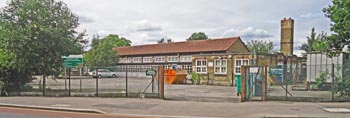Knotts
Green Open Air School
99 Leyton Green Road, Leyton, E10 6DB
Medical
dates:
Medical
character:
Open Air School
In 1927 the school board of
Leyton Urban District Council established two special schools sharing
the same site in Leyton Green. One was for mentally defective
children and the other for the physically defective, both under the
name of the Knotts Green Special Schools. (Knotts Green is an
adjacent open space, and the original name for the district -
indeed Leyton Green Road - was Knotts Green Road.)
The Knotts Green Open Air School (also known as the Havering Open Air School and Leyton Open Air School) for 150 physically defective children was on the southern part of the site. It operated on open air principles, based around a long two-storey shed-like building.
Many of the children suffered from lung or heart disorders, such as bronchitis, ashthma, bronchiectasis, fibrosis of the lungs, rheumatic carditis, or had orthopaedic conditions. Some were epileptic,malnourished, anaemic or simply 'delicate'.
Classes were held in the open air whenever possible. The children were given a well-cooked dinner at mid day, after which they had a rest period.
During the 1930s the rates of improvement increased, from 64% in 1933 to 87% in 1938. Some children received artificial light treatment. Cod liver oil and malt were also prescribed. All put on weight, gaining some 7 to 13 ounces (200-360 grams) a month. Those with inactive rheumatic disease of the heart did particularly well at the School.
By 1938 the proportion of undernourished children had greatly increased - to 68 out of 161 pupils. The next largest category was 'crippled children' (27), followed by 'delicate children' (21) and those with rheumatic carditis (21).
In July 1938 the first camping trip to Dymchurch was arranged for 24 boys and 2 masters, where the principles of open air treatment were adhered to, with the mandatory hour's rest at midday.
Prior to the outbreak of WW2 attendance at the School varied from 80 to 100 pupils, but at the end of the war there were only about 30 to 40. It was expected that the numbers would increase during the post-war period and, for a while, they did.
However, with the improving health of schoolchildren and the general rise in the standard of living, by 1955 the number of pupils had fallen to about 30. It was considered not economically viable for the School to continue, especially as there was a long waiting list for admission to the nearby Harrow Green Educationally Sub-normal School.
Therefore, the Open Air School closed in 1955.
The Knotts Green Open Air School (also known as the Havering Open Air School and Leyton Open Air School) for 150 physically defective children was on the southern part of the site. It operated on open air principles, based around a long two-storey shed-like building.
Many of the children suffered from lung or heart disorders, such as bronchitis, ashthma, bronchiectasis, fibrosis of the lungs, rheumatic carditis, or had orthopaedic conditions. Some were epileptic,malnourished, anaemic or simply 'delicate'.
Classes were held in the open air whenever possible. The children were given a well-cooked dinner at mid day, after which they had a rest period.
During the 1930s the rates of improvement increased, from 64% in 1933 to 87% in 1938. Some children received artificial light treatment. Cod liver oil and malt were also prescribed. All put on weight, gaining some 7 to 13 ounces (200-360 grams) a month. Those with inactive rheumatic disease of the heart did particularly well at the School.
By 1938 the proportion of undernourished children had greatly increased - to 68 out of 161 pupils. The next largest category was 'crippled children' (27), followed by 'delicate children' (21) and those with rheumatic carditis (21).
In July 1938 the first camping trip to Dymchurch was arranged for 24 boys and 2 masters, where the principles of open air treatment were adhered to, with the mandatory hour's rest at midday.
Prior to the outbreak of WW2 attendance at the School varied from 80 to 100 pupils, but at the end of the war there were only about 30 to 40. It was expected that the numbers would increase during the post-war period and, for a while, they did.
However, with the improving health of schoolchildren and the general rise in the standard of living, by 1955 the number of pupils had fallen to about 30. It was considered not economically viable for the School to continue, especially as there was a long waiting list for admission to the nearby Harrow Green Educationally Sub-normal School.
Therefore, the Open Air School closed in 1955.
Present status (August 2013)
When the Open Air School ceased, its site - renamed Leyton Green School - was used from September 1955 as an annexe to Harrow Green E.S.N. School (the successor to the mentally handicapped school originally sharing the Knotts Green site, which had moved out in 1948).
The original shed-like building of the Open Air School appears to have survived more of less intact. It is now the Summerfield Centre, housing the local educational psychology services for Waltham Forest borough.
The remainder of the Knotts Green site, originally housing the mentally handicapped school and, later, a day nursery, now accommodates the recently built Belmont Park School, a Special School for 60 children with challenging behaviours.

The Summerfield Centre.

Belmont Park School.
www.british-history.ac.uk
www.wellcomelibrary.org (1)
www.wellcomelibrary.org (2)
www.wellcomelibrary.org (3)
www.wellcomelibrary.org (4)
Return to home page